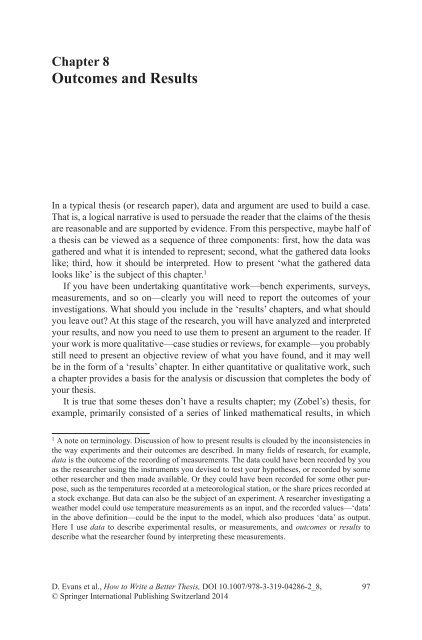How-to-Write-a-Better-Thesis
You also want an ePaper? Increase the reach of your titles
YUMPU automatically turns print PDFs into web optimized ePapers that Google loves.
Chapter 8<br />
Outcomes and Results<br />
In a typical thesis (or research paper), data and argument are used <strong>to</strong> build a case.<br />
That is, a logical narrative is used <strong>to</strong> persuade the reader that the claims of the thesis<br />
are reasonable and are supported by evidence. From this perspective, maybe half of<br />
a thesis can be viewed as a sequence of three components: first, how the data was<br />
gathered and what it is intended <strong>to</strong> represent; second, what the gathered data looks<br />
like; third, how it should be interpreted. <strong>How</strong> <strong>to</strong> present ‘what the gathered data<br />
looks like’ is the subject of this chapter. 1<br />
If you have been undertaking quantitative work—bench experiments, surveys,<br />
measurements, and so on—clearly you will need <strong>to</strong> report the outcomes of your<br />
investigations. What should you include in the ‘results’ chapters, and what should<br />
you leave out? At this stage of the research, you will have analyzed and interpreted<br />
your results, and now you need <strong>to</strong> use them <strong>to</strong> present an argument <strong>to</strong> the reader. If<br />
your work is more qualitative—case studies or reviews, for example—you probably<br />
still need <strong>to</strong> present an objective review of what you have found, and it may well<br />
be in the form of a ‘results’ chapter. In either quantitative or qualitative work, such<br />
a chapter provides a basis for the analysis or discussion that completes the body of<br />
your thesis.<br />
It is true that some theses don’t have a results chapter; my (Zobel’s) thesis, for<br />
example, primarily consisted of a series of linked mathematical results, in which<br />
1<br />
A note on terminology. Discussion of how <strong>to</strong> present results is clouded by the inconsistencies in<br />
the way experiments and their outcomes are described. In many fields of research, for example,<br />
data is the outcome of the recording of measurements. The data could have been recorded by you<br />
as the researcher using the instruments you devised <strong>to</strong> test your hypotheses, or recorded by some<br />
other researcher and then made available. Or they could have been recorded for some other purpose,<br />
such as the temperatures recorded at a meteorological station, or the share prices recorded at<br />
a s<strong>to</strong>ck exchange. But data can also be the subject of an experiment. A researcher investigating a<br />
weather model could use temperature measurements as an input, and the recorded values—‘data’<br />
in the above definition—could be the input <strong>to</strong> the model, which also produces ‘data’ as output.<br />
Here I use data <strong>to</strong> describe experimental results, or measurements, and outcomes or results <strong>to</strong><br />
describe what the researcher found by interpreting these measurements.<br />
D. Evans et al., <strong>How</strong> <strong>to</strong> <strong>Write</strong> a <strong>Better</strong> <strong>Thesis</strong>, DOI 10.1007/978-3-319-04286-2_8,<br />
© Springer International Publishing Switzerland 2014<br />
97














![[Lonely Planet] Sri Lanka](https://img.yumpu.com/59845622/1/169x260/lonely-planet-sri-lanka.jpg?quality=85)


